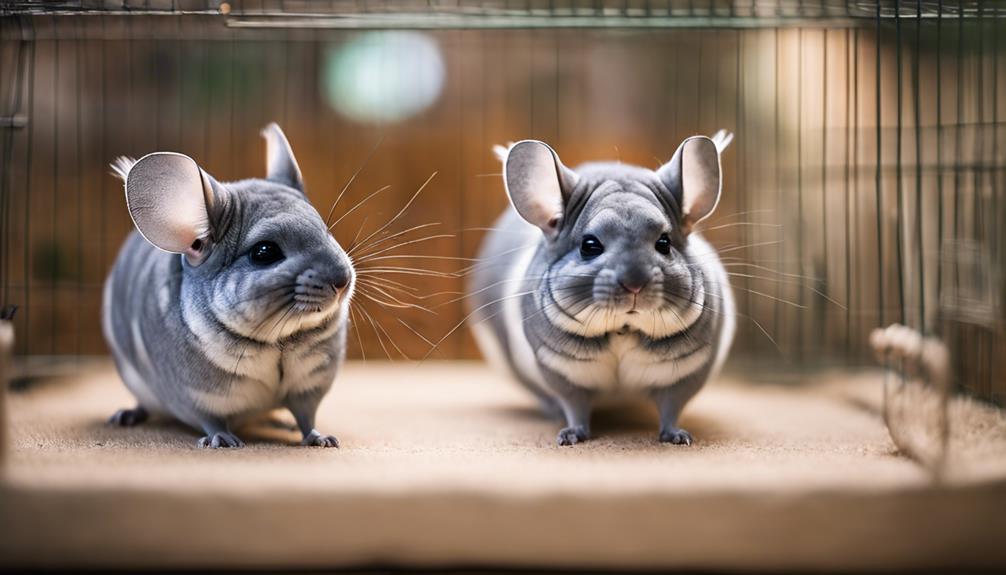What Is the Difference Between Long-Tailed and Short-Tailed Chinchillas?

Long-tailed chinchillas have longer tails than short-tailed chinchillas. These differences extend beyond just their tail lengths.
Physical Characteristics
Long-tailed chinchillas exhibit elongated tails that distinguish them from their short-tailed counterparts. These chinchillas typically have a body size ranging from 9 to 15 inches in length, with males being slightly larger than females. When it comes to coat coloration, long-tailed chinchillas display a wide array of colors such as grey, black, white, beige, and even violet hues. The texture of their fur is incredibly soft and dense, serving as a natural defense against the cold in their native Andean habitat.
In terms of body size, long-tailed chinchillas are known for their slender build and agile movements. Their bodies are well-proportioned, with a compact head and large, expressive eyes. The coat coloration plays a crucial role in camouflaging these chinchillas in the rocky terrains they inhabit, offering them protection from predators. Long-tailed chinchillas are truly fascinating creatures, showcasing a blend of physical characteristics that make them unique in the animal kingdom.
Tail Length Distinction

Chinchilla tail length is determined by a combination of genetic factors, including the influence of specific genes that control tail length.
The evolution of tail length in chinchillas is believed to be linked to their natural habitats and ecological roles, with longer tails potentially providing advantages such as improved balance or communication.
Functionally, the length of a chinchilla's tail may affect its agility, thermoregulation capabilities, or even social interactions within a group.
Tail Length Genetics
Tail length in chinchillas is determined by a specific genetic trait that influences the length of their tails. Genetic inheritance plays a significant role in determining whether a chinchilla will have a long tail or a short tail. Variations in tail length can be traced back to the specific genes passed down from the chinchilla's parents.
Through a complex interplay of genetic factors, some chinchillas inherit the genetic predisposition for longer tails, while others inherit the genes for shorter tails. Understanding the genetic basis for tail length variations can provide insights into the hereditary mechanisms that govern this trait within chinchilla populations.
Evolutionary Tail Adaptation
Evolutionary adaptations in chinchillas have resulted in distinct variations in tail length, reflecting their specialized genetic makeup and ecological niche.
The long-tailed chinchillas, native to the Andes Mountains, have evolved with lengthy tails that provide them with balance and agility in rocky terrains. On the other hand, short-tailed chinchillas, found in the coastal regions, have shorter tails that offer them better maneuverability in dense vegetation.
This difference in tail length confers an evolutionary advantage to each species based on their habitats. The ecological significance of tail length adaptation lies in the chinchillas' ability to navigate their environments effectively, enhancing their survival and reproductive success.
Through natural selection, chinchillas have tailored their tails to suit the specific challenges posed by their habitats.
Tail Function Differences
Balancing on rocky terrains, the long-tailed chinchilla's lengthy tail provides essential stability and agility in its environment. This distinct tail length variation between long-tailed and short-tailed chinchillas plays a crucial role in their daily lives.
- Tail Balance: The long-tailed chinchilla's extended tail acts as a counterbalance, aiding in maintaining equilibrium while navigating uneven surfaces.
- Communication Signals: Long-tailed chinchillas utilize their tails to communicate with others of their kind through subtle movements and gestures.
- Agility Enhancement: The length of the tail enhances the long-tailed chinchilla's overall agility, allowing for swift movements and quick reflexes in response to potential threats or challenges.
Habitat Preferences

Long-tailed and short-tailed chinchillas exhibit distinct preferences for specific habitats based on their natural behaviors and environmental adaptations. Long-tailed chinchillas, being more sociable, tend to thrive in larger colonies and prefer areas with more hiding spots for their young. Short-tailed chinchillas, on the other hand, are less social and often prefer more solitary living conditions in the wild, seeking out smaller, secluded spaces. These habitat preferences are closely tied to their diet requirements, social behavior, communication methods, and nesting habits.
| Long-Tailed Chinchillas | Short-Tailed Chinchillas |
|---|---|
| Larger colonies | Solitary living |
| Prefer areas with hiding spots | Seek smaller, secluded spaces |
| Thrive in more social environments | Less social, prefer solitude |
| More vocal communication | Limited vocalizations |
Understanding these habitat preferences is crucial for creating suitable environments for both long-tailed and short-tailed chinchillas in captivity, ensuring their well-being and natural behaviors are supported.
Behavioral Variances

When comparing the behavioral variances between long-tailed and short-tailed chinchillas, observing their interactions with conspecifics reveals significant differences in social dynamics. Long-tailed chinchillas tend to exhibit more territorial behavior compared to their short-tailed counterparts. This territoriality often leads to aggressive interactions when encountering unfamiliar individuals.
On the other hand, short-tailed chinchillas are more social and display a higher degree of tolerance towards other members of their group. Understanding these social dynamics is crucial for providing appropriate housing and socialization opportunities for both species.
Key Points:
- Long-tailed chinchillas show territorial behavior
- Short-tailed chinchillas are more social
- Differences in social dynamics impact housing and socialization strategies
Reproductive Variedness

Observing the reproductive behaviors of long-tailed and short-tailed chinchillas sheds light on their distinct reproductive variedness, highlighting differences in mating strategies and breeding patterns. Long-tailed chinchillas typically have shorter reproductive cycles compared to short-tailed chinchillas. Long-tailed chinchillas can go into estrus every 28-35 days, while short-tailed chinchillas have longer cycles of 35-45 days. This variation affects their mating behaviors, with long-tailed chinchillas being more frequent breeders than short-tailed chinchillas.
Mating behaviors also differ between the two species. Long-tailed chinchillas are known to be more aggressive during mating, often displaying dominance behaviors. In contrast, short-tailed chinchillas tend to be more passive during mating, with less aggression exhibited. These differences in mating behaviors can impact breeding success and offspring production in captivity. Understanding these reproductive variations is crucial for effectively managing and breeding both long-tailed and short-tailed chinchillas in captivity.
Care and Maintenance Needs

Care and maintenance needs for both long-tailed and short-tailed chinchillas vary based on their specific habitat requirements and dietary preferences. Chinchillas are adorable pets that require specific care to thrive. Here are some key aspects to consider when caring for these furry creatures:
- Grooming Needs: Both long-tailed and short-tailed chinchillas need regular dust baths to maintain their fur's cleanliness and health. A dust bath helps remove excess oils and moisture from their coat, preventing skin issues.
- Diet Requirements: Chinchillas have sensitive digestive systems and require a diet high in fiber. Their diet should consist mainly of hay, supplemented with pellets made specifically for chinchillas. Fresh water should always be available to keep them hydrated.
- Environmental Considerations: Chinchillas are sensitive to heat and humidity, so their living space should be well-ventilated and kept at a cool temperature. Additionally, they need a spacious cage with platforms for exercise and mental stimulation.
Popularity as Pets

Chinchillas have gained popularity as pets in recent years due to their charming personalities and low maintenance requirements. These rodents have specific grooming habits that involve dust baths to keep their fur clean and healthy.
In terms of exercise routines, chinchillas are active animals that require a spacious cage with platforms and toys to climb and play. Their dietary requirements consist of a diet high in fiber, including hay and pellets, to maintain their dental health and digestion.
When it comes to social interactions, chinchillas are known to be social creatures that can thrive with proper handling and companionship. They enjoy interacting with their owners and can form strong bonds with them over time. However, it's essential to introduce chinchillas to each other carefully to prevent aggression.
Frequently Asked Questions
Are Long-Tailed Chinchillas More Prone to Certain Health Issues Compared to Short-Tailed Chinchillas?
Long-tailed chinchillas may exhibit a higher prevalence of health issues than their short-tailed counterparts due to tail length impacting genetic predisposition. Tail length can influence specific health concerns in chinchillas, warranting careful monitoring.
Do Long-Tailed and Short-Tailed Chinchillas Have Different Dietary Requirements?
Long-tailed and short-tailed chinchillas have distinct dietary requirements. Their dental health and weight management depend on specialized diets tailored to their chewing habits and exercise needs. Providing appropriate nutrition is crucial for their overall well-being.
Can Long-Tailed and Short-Tailed Chinchillas Interbreed With Each Other?
Curiosity piqued, enthusiasts wonder about genetic compatibility between long-tailed and short-tailed chinchillas. These species, with distinct physical features and behavioral traits, can interbreed due to similar breeding habits. Their offspring showcase a mix of characteristics.
Are There Any Specific Grooming Needs That Differ Between Long-Tailed and Short-Tailed Chinchillas?
Long-tailed and short-tailed chinchillas have distinct grooming needs. Their shedding patterns and coat care differ significantly. Specific grooming techniques and hygiene practices are necessary to maintain the health and well-being of these adorable rodents.
How Do Long-Tailed and Short-Tailed Chinchillas Differ in Terms of Vocalizations and Communication Methods?
Long-tailed and short-tailed chinchillas communicate through various vocalizations and body language. Long-tailed chinchillas are known for their more extensive social behavior and intricate mating rituals, while short-tailed chinchillas exhibit distinct reproductive patterns and communication methods.











